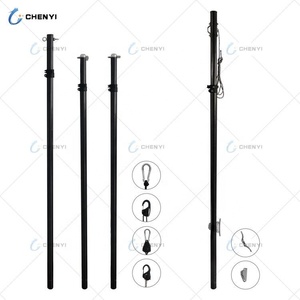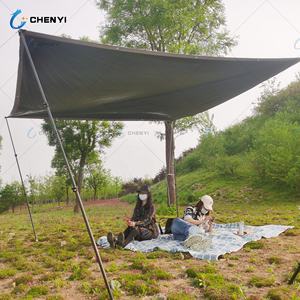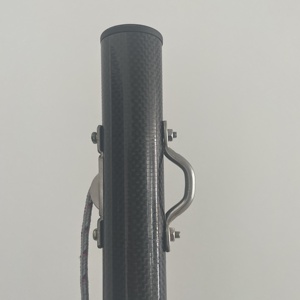
All categories
Featured selections
Trade Assurance
Buyer Central
Help Center
Get the app
Become a supplier

(5112 products available)











































Sun shade poles are essential elements of outdoor spaces. They support sun shades, which protect against harmful UV rays and light rain. These poles are sturdy and reliable, made from durable materials like aluminum or galvanized steel, ensuring they can withstand the rigors of outdoor use and harsh weather conditions. They come in various sizes and heights to accommodate different types of shades, such as umbrellas, awnings, and sail shades. The versatility of sunshade poles makes them suitable for gardens, restaurants, and beaches, among other outdoor venues. They create cool, comfortable zones to relax and enjoy, enhancing the functionality and aesthetics of the space.
Additionally, sun shade poles can be used in commercial settings, including terraces, courtyards, and pool areas, thereby increasing revenue through added space. The practical design of these poles allows for easy installation and maintenance, making them a convenient choice for both residential and commercial use. With options for customization and a range of accessories available, sun shade poles can be tailored to fit specific needs and preferences. In conclusion, sun shade poles are a practical and beneficial addition to any outdoor area, offering protection from the sun, rain, and enhancing the overall comfort and enjoyment of the space.
The market offers various types of sunshade pole accessories to enhance outdoor space. Each type has characteristics that make it suitable for specific applications and preferences.
Fixed sun shade poles
Fixed sunshade poles are permanent fixtures designed to provide a stable foundation for sunshades. They are commonly used in commercial settings such as restaurants, cafes, and outdoor event spaces, where large areas need coverage. Typically made of sturdy materials like steel or concrete, these poles are anchored securely into the ground, ensuring they can withstand wind and other weather conditions.
Adjustable sun shade poles
As the name suggests, the height and angle of adjustable sun shade poles can be changed. They are ideal for situations where the position of the sun changes throughout the day, requiring different shade angles. Often used in residential gardens or patios, these poles allow users to customize their sunshade experience. Some adjustable models have telescopic designs, enabling users to extend or retract the pole's length as needed.
Modular sun shade poles
Modular sun shade poles are versatile and adaptable. They can be easily assembled and disassembled, making them perfect for temporary or portable use. These poles are commonly used for outdoor events, festivals, or camping. Made from lightweight materials like aluminum or PVC, modular sun shade poles are easy to transport and store. They often come with various attachments, such as umbrella-like canopies or awning extensions, to create different shading solutions.
Decorative sun shade poles
Decorative sun shade poles combine functionality with aesthetics. They are designed to enhance the visual appeal of outdoor spaces while providing shade. Decorative poles can be found in various styles, from ornate and traditional to sleek and modern. They can be used in gardens, courtyards, or outdoor dining areas, adding a touch of elegance to the environment. Decorative sun shade poles often have intricate patterns, unique finials, or decorative paint finishes.
Sunshade poles are designed to be easy to use and move. They usually have a strong but light structure made of metal or hard plastic. This allows one person to set them up or take them down quickly. Some sunshade poles come with wheels or fold up for convenient storage and transport. They can be used with umbrellas, awnings, or outdoor screens to block sunlight in gardens, patios, or balconies, among other things.
Material Options:
Sun shade poles are made of different materials. These include steel, aluminum, and hard plastics like PVC. Each material has its benefits. For example, metal poles are strong. Plastic poles are cheaper and lighter.
Height and Adjustability:
The standard height for sunshade poles is 8 feet. Some have adjustable heights to fit different shades or sun angles. This flexibility allows for better shade coverage and can accommodate various outdoor settings and events.
Base Design:
Sun shade poles have different base designs. The base can be a cemented fixture for permanent setups or a removable base that can be filled with water or sand for temporary use. Removable bases often have wheels for easy movement of the poles.
Color Options:
Sunshade poles come in many colors. The most common are gray, black, and white. Some manufacturers offer custom colors to match the design theme of a specific outdoor space or event.
Texture and Finish:
Sun shade poles have different textures and finishes. These range from smooth and shiny to rough and matte. Textured finishes can provide better grip for handling and add visual interest to the pole's design.
Shape and Style:
The shape of the sunshade pole affects its stability and style. Common shapes include cylindrical, square, and tapered designs. Some poles have decorative elements like patterns or embellishments to enhance their appearance in residential or commercial settings.
Sun shade poles are practical and efficient. They have many applications in different industries. These are some scenarios where one can use sun shade poles:
Outdoor Restaurants and Cafes:
Sun shade poles create shaded areas for customers to dine. They hold up the fabric or mesh shades. The shades keep the sun out and make a comfortable place to sit. The poles can support shades of different sizes and shapes. They can be fixed or movable. The shades help the restaurant stay cool and save energy. They reduce the need for air conditioning.
Playgrounds and Parks:
In public spaces, sun shade poles protect kids and adults from the sun. They make shaded areas in parks and playgrounds. The poles can support large shades that cover many people. They also add to the beauty of the park. The poles are strong and last a long time. They need very little care.
Sports Facilities:
Sun shade poles keep players and fans cool. They make shaded areas on the field or court. The poles support shades for outdoor sports like tennis or basketball. They also make shaded areas for seating. The shades keep the spectators comfortable. The poles are strong enough to hold large shades. They can also withstand the rigors of a sports environment.
Car Dealerships:
Sun shade poles protect cars from UV rays and heat. They create a cool, shaded area to display vehicles. The poles hold up large shades that cover many cars. The shades help keep the cars looking new. They also help keep the showroom cool.
Commercial and Retail Spaces:
Sun shade poles can be used in the construction of malls and shops. They create shaded areas at the entrance or along walkways. The shades keep the store cool. They also reduce glare. This makes it easier for customers to see the products on display.
Event Spaces and Outdoor Weddings:
At outdoor events, sun shade poles make a comfortable, shaded area. They can support the shades over dining or seating areas. The poles are also used to hold decorative canopies. The shades protect guests from the sun and help keep the area cool.
Wholesale buyers need to consider these factors when choosing sun shade poles for outdoor spaces.
Target Market
Understand the target customers. Do they want commercial-grade sun shade poles or residential ones? Are they in a hot climate or a cold climate? Selling to customers in warm climates may require more durable and UV-resistant poles.
Durability and Longevity
Choose poles made with durable materials like powder-coated steel or aluminum. These materials can withstand harsh weather. Also, pick poles with good UV resistance. It helps the poles resist damage from the sun. Check the warranty. A long warranty usually indicates a durable product.
Ease of Installation
Look for poles with user-friendly installation. These poles will have clear instructions and all needed hardware. Consider poles that allow for easy adjustments and secure fittings. These features ensure a stable and tight shade structure.
Safety Features
Find poles with safety features like rounded edges and secure locking mechanisms. These features prevent accidents during installation and use. Ensure the poles meet local safety standards. It is needed to protect users and reduce liability for the buyer.
Color and Style
Choose sun shade poles with colors and styles that match outdoor areas. Neutral colors like black, gray, and beige offer versatility. They can blend well with different landscapes. Consider adding custom color options. They can allow for branding and differentiation in the market.
Shade Coverage
Ensure the sun shade poles can support various sizes of shade sails and umbrellas. The poles should have the strength to hold large shades but remain stable for smaller ones. It allows for flexibility in design and customer needs.
Q1: How can one secure a sun shade pole in the ground?
A1: Dig a hole in the ground that is at least one-third of the height of the sun shade pole. Place the pole in the hole and fill it with concrete. For temporary poles, use removable pole anchors that grip the pole tightly.
Q2: How does one adjust the height of a sun shade pole?
A2: Some poles have telescopic designs with pin-lock mechanisms. Loosen the locking pins, slide the pole to the desired height, then re-secure the pins. Others may require the adjustment of removable extensions at the top.
Q3: What is the average lifespan of a sun shade pole?
A3: Durable steel and aluminum poles can last 15 to 25 years with proper installation and maintenance. Fiberglass poles can last 10 to 15 years, while PVC poles may only last 5 to 10 years.
Q4: Can sun shade poles be used in winter?
A4: Yes, sun shades are temporary structures that can be used year-round. However, it may be necessary to remove the shade sails or fabrics in extreme winter weather to prevent damage from heavy snow or ice.
Q5: How can one clean a dirty sun shade pole?
A5: Wash the pole with soapy water and a sponge. Rinse it thoroughly with clean water. For aluminum poles, use a mild metal polish to clean a fiberglass or PVC pole's discoloration.